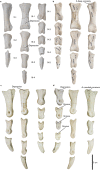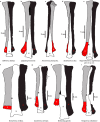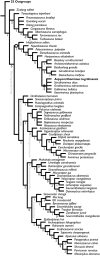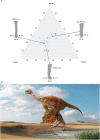First Ornithomimid (Theropoda, Ornithomimosauria) from the Upper Cretaceous Djadokhta Formation of Tögrögiin Shiree, Mongolia
- PMID: 28724887
- PMCID: PMC5517598
- DOI: 10.1038/s41598-017-05272-6
First Ornithomimid (Theropoda, Ornithomimosauria) from the Upper Cretaceous Djadokhta Formation of Tögrögiin Shiree, Mongolia
Erratum in
-
Author Correction: First Ornithomimid (Theropoda, Ornithomimosauria) from the Upper Cretaceous Djadokhta Formation of Tögrögiin Shiree, Mongolia.Sci Rep. 2018 Apr 11;8(1):6045. doi: 10.1038/s41598-018-23583-0. Sci Rep. 2018. PMID: 29643412 Free PMC article.
-
Author Correction: First Ornithomimid (Theropoda, Ornithomimosauria) from the Upper Cretaceous Djadokhta Formation of Tögrögiin Shiree, Mongolia.Sci Rep. 2020 Jan 27;10(1):1494. doi: 10.1038/s41598-020-58481-x. Sci Rep. 2020. PMID: 31988318 Free PMC article.
Abstract
The Upper Cretaceous Djadokhta Formation has been intensively surveyed for its fossil vertebrate fauna for nearly a century. Amongst other theropods, dromaeosaurids and parvicursorines are common in the formation, but ornithomimosaurs are extremely rare. A new ornithomimosaur material was discovered from the Djadokhta Formation, represented by eolian deposits, of the Tögrögiin Shiree locality, Mongolia. This is only the third ornithomimosaur specimen reported from this formation, and includes the astragalus, the calcaneum, the third distal tarsal, and a complete pes. The new material is clearly belonged to Ornithomimidae by its arctometatarsalian foot condition and has the following unique characters; unevenly developed pair of concavities of the third distal tarsal, curved contacts between the proximal ends of second and fourth metatarsals, the elongate fourth digit, and a laterally inclined medial condyle on phalanx IV-1. These diagnostic characters of the Djadokhtan ornithomimosaur indicate that this is a new taxon. Our phylogenetic analysis supports three clades within derived ornithomimosaurs, and the new taxon is placed a member of the derived ornithomimosaurs. The present specimen is the first ornithomimid record from eolian Tögrögiin Shiree locality, and is indicative of their capability to adapt to arid environments.
Conflict of interest statement
The authors declare that they have no competing interests.
Figures








Similar articles
-
Author Correction: First Ornithomimid (Theropoda, Ornithomimosauria) from the Upper Cretaceous Djadokhta Formation of Tögrögiin Shiree, Mongolia.Sci Rep. 2018 Apr 11;8(1):6045. doi: 10.1038/s41598-018-23583-0. Sci Rep. 2018. PMID: 29643412 Free PMC article.
-
Author Correction: First Ornithomimid (Theropoda, Ornithomimosauria) from the Upper Cretaceous Djadokhta Formation of Tögrögiin Shiree, Mongolia.Sci Rep. 2020 Jan 27;10(1):1494. doi: 10.1038/s41598-020-58481-x. Sci Rep. 2020. PMID: 31988318 Free PMC article.
-
Resolving the long-standing enigmas of a giant ornithomimosaur Deinocheirus mirificus.Nature. 2014 Nov 13;515(7526):257-60. doi: 10.1038/nature13874. Epub 2014 Oct 22. Nature. 2014. PMID: 25337880
-
A giant ornithomimosaur from the Early Cretaceous of China.Proc Biol Sci. 2010 Jan 22;277(1679):191-8. doi: 10.1098/rspb.2009.0236. Epub 2009 Apr 22. Proc Biol Sci. 2010. PMID: 19386658 Free PMC article.
-
The theropod furcula.J Morphol. 2009 Jul;270(7):856-79. doi: 10.1002/jmor.10724. J Morphol. 2009. PMID: 19206153 Review.
Cited by
-
Quantifying the effects of exceptional fossil preservation on the global availability of phylogenetic data in deep time.PLoS One. 2024 Feb 14;19(2):e0297637. doi: 10.1371/journal.pone.0297637. eCollection 2024. PLoS One. 2024. PMID: 38354167 Free PMC article.
-
A new alvarezsaurid dinosaur (Theropoda, Alvarezsauria) from the Upper Cretaceous Baruungoyot Formation of Mongolia provides insights for bird-like sleeping behavior in non-avian dinosaurs.PLoS One. 2023 Nov 15;18(11):e0293801. doi: 10.1371/journal.pone.0293801. eCollection 2023. PLoS One. 2023. PMID: 37967055 Free PMC article.
-
New theropod dinosaur from the Lower Cretaceous of Japan provides critical implications for the early evolution of ornithomimosaurs.Sci Rep. 2023 Sep 7;13(1):13842. doi: 10.1038/s41598-023-40804-3. Sci Rep. 2023. PMID: 37679444 Free PMC article.
-
Non-avian theropod phalanges from the marine Fox Hills Formation (Maastrichtian), western South Dakota, USA.PeerJ. 2023 Feb 7;11:e14665. doi: 10.7717/peerj.14665. eCollection 2023. PeerJ. 2023. PMID: 36778140 Free PMC article.
-
Large-bodied ornithomimosaurs inhabited Appalachia during the Late Cretaceous of North America.PLoS One. 2022 Oct 19;17(10):e0266648. doi: 10.1371/journal.pone.0266648. eCollection 2022. PLoS One. 2022. PMID: 36260601 Free PMC article.
References
-
- JI QIANG, NORELL MARK A., MAKOVICKY PETER J., GAO KE-QIN, JI SHU'AN, YUAN CHONGXI. An Early Ostrich Dinosaur and Implications for Ornithomimosaur Phylogeny. American Museum Novitates. 2003;3420(1):1.
-
- Kobayashi Y, Lü J. A new ornithomimid dinosaur with gregarious habits from the Late Cretaceous of China. Acta Palaeontologica Polonica. 2003;48:235–259.
-
- Ksepka DT, Norell MA. Ornithomimosaur cranial material from Ukhaa Tolgod (Omnogov, Mongolia) American Museum Novitates. 2004;3448:1–4.
-
- Lee Y-N, et al. Resolving the long-standing enigmas of a giant ornithomimosaur Deinocheirus mirificus. Nature. 2014;515:257–60. - PubMed
-
- Makovicky, P. J., Kobayashi, Y. & Currie, P. J. in The Dinosauria (eds Weishampel, D. B., Dodson, P. & Osmólska, H.) 137–150 (University of California Press [AQ1], 2004).
MeSH terms
LinkOut - more resources
Full Text Sources
Other Literature Sources


